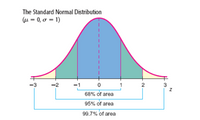
Concept explainers
Fawns between 1 and 5 months old have a body weight that is approximately
(g) If a fawn weighs 14 kilograms, would you say it is an unusually small animal? Explain using z values and the figure above.
A. Yes. This weight is 3.71 standard deviations below the mean; 14 kg is an unusually low weight for a fawn.
B. Yes. This weight is 1.85 standard deviations below the mean; 14 kg is an unusually low weight for a fawn.
C. No. This weight is 3.71 standard deviations below the mean; 14 kg is a normal weight for a fawn.
D. No. This weight is 3.71 standard deviations above the mean; 14 kg is an unusually high weight for a fawn.
E. No. This weight is 1.85 standard deviations above the mean; 14 kg is an unusually high weight for a fawn.
(h) If a fawn is unusually large, would you say that the z value for the weight of the fawn will be close to 0, −2, or 3? Explain.
A. It would have a negative z, such as −2.
B. It would have a large positive z, such as 3.
C. It would have a z of 0.

Trending nowThis is a popular solution!
Step by stepSolved in 3 steps

- Please help me with this question.arrow_forwardPrevious Question Researchers measured the data speeds for a particular smartphone carier at 50 airports. The highest speed measured was T76 Mbps. The complete list of 50 data speeds has a mean of x 17.47 Mbps and a standard deviation of s 32.99 Mbps. a. What is the dilference between camer's highest data speed and the mean of all 50 data speeds? b. How many standard deviations is that (the difference found in part (a)? c Convert the camer's highest data speed to az score. d. If we consider data speeds that convert to z scores between-2 and 2 to be neither significantly low nor significantly high, is the camier's highest data speed significant? a. The difference is Mbps (Type an integer or a decimal Do not round) b. The dilference is standard deviations (Round to two decimal places as needed.) c The z score is z (Round to two decimal places as needed.) d. The camer's highest data speed isarrow_forwardThe mean is 146 and the standard deviation is 35. A score of 41 is how many z-scores below the mean?arrow_forward
- Gestation Periods of Humans. Gestation periods of humans have a mean of 266 days and a standard deviation of 16 days. Let y denote the variable "gestation period" for humans.a. Find the standardized variable corresponding to y.b. What are the mean and standard deviation of the standardized variable?c. Obtain the z-scores for gestation periods of 227 days and 315 days. Round your answers to two decimal places.d. Interpret your answers in part (c).arrow_forwardAnswer the question in the second photo with the data provided in the first photoarrow_forwardCereals sodium values have a mean of 167 and a standard deviation of 77.3. Find the z-score for the cereal that has a sodium value of 0. How would you interpret this z-score?arrow_forward
 MATLAB: An Introduction with ApplicationsStatisticsISBN:9781119256830Author:Amos GilatPublisher:John Wiley & Sons Inc
MATLAB: An Introduction with ApplicationsStatisticsISBN:9781119256830Author:Amos GilatPublisher:John Wiley & Sons Inc Probability and Statistics for Engineering and th...StatisticsISBN:9781305251809Author:Jay L. DevorePublisher:Cengage Learning
Probability and Statistics for Engineering and th...StatisticsISBN:9781305251809Author:Jay L. DevorePublisher:Cengage Learning Statistics for The Behavioral Sciences (MindTap C...StatisticsISBN:9781305504912Author:Frederick J Gravetter, Larry B. WallnauPublisher:Cengage Learning
Statistics for The Behavioral Sciences (MindTap C...StatisticsISBN:9781305504912Author:Frederick J Gravetter, Larry B. WallnauPublisher:Cengage Learning Elementary Statistics: Picturing the World (7th E...StatisticsISBN:9780134683416Author:Ron Larson, Betsy FarberPublisher:PEARSON
Elementary Statistics: Picturing the World (7th E...StatisticsISBN:9780134683416Author:Ron Larson, Betsy FarberPublisher:PEARSON The Basic Practice of StatisticsStatisticsISBN:9781319042578Author:David S. Moore, William I. Notz, Michael A. FlignerPublisher:W. H. Freeman
The Basic Practice of StatisticsStatisticsISBN:9781319042578Author:David S. Moore, William I. Notz, Michael A. FlignerPublisher:W. H. Freeman Introduction to the Practice of StatisticsStatisticsISBN:9781319013387Author:David S. Moore, George P. McCabe, Bruce A. CraigPublisher:W. H. Freeman
Introduction to the Practice of StatisticsStatisticsISBN:9781319013387Author:David S. Moore, George P. McCabe, Bruce A. CraigPublisher:W. H. Freeman





